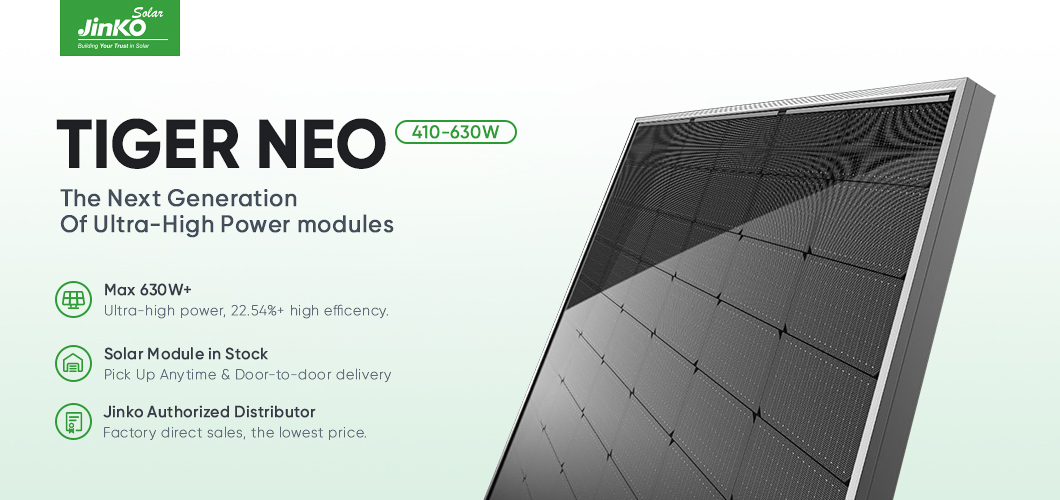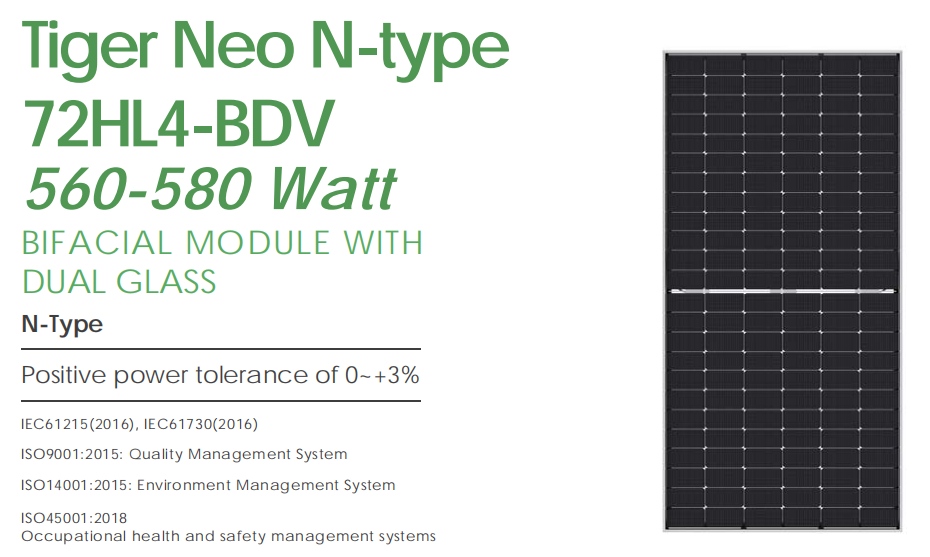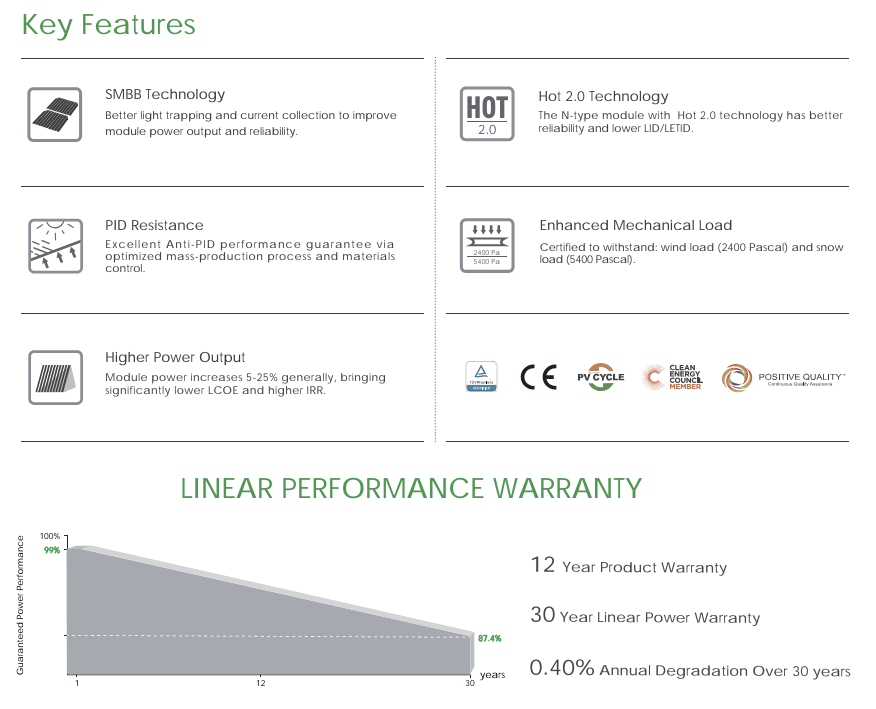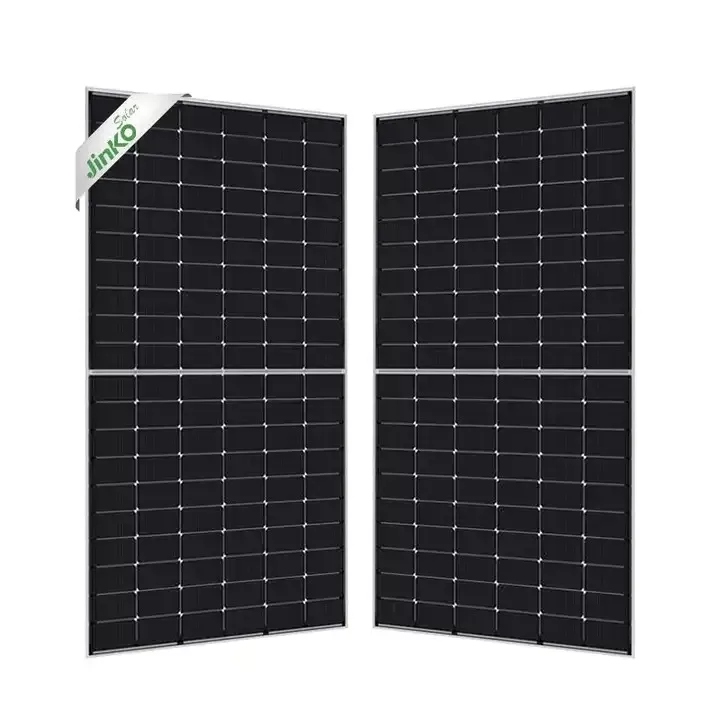JinkoSolar JKM-N-72HL4RBDV 585W is a high-efficiency solar panel developed by JinkoSolar, one of the leading solar module manufacturers globally. This particular model is designed for residential and commercial applications, offering excellent performance and reliable energy generation.
Power Range:
575W-585WMax. Efficiency:
22.64%Dimensions of Module L*W*H:
2278*1134*30mmWeight:
32 kgNumber of Cells:
144 (6 * 24)
The JinkoSolar JKM-N-72HL4RBDV 585W solar panel combines high efficiency, advanced technology, and exceptional durability to provide reliable and sustainable energy generation in residential and commercial applications. With its innovative features and industry certifications, this solar panel is an excellent choice for those seeking high-performance solar solutions.

Electrical Parameters (STC*)
|
Module model |
JKM575NN-72HL4RBDV |
JKM580NN-72HL4RBDV |
JKM585NN-72HL4RBDV |
|
Maximum Power (Pmax/W) |
575 |
580 |
585 |
|
Open circuit voltage (Voc/V) |
51.27 |
51.47 |
51.67 |
|
Short circuit current (Isc/A) |
14.31 |
14.37 |
14.43 |
|
Peak power voltage (Vmp/V) |
42.44 |
42.59 |
42.74 |
|
Peak power current (Imp/A) |
13.55 |
13.62 |
13.69 |
|
Module Efficiency (%) |
22.26 |
22.45 |
22.64 |
|
Power Output Tolerance (W) |
0~3% |
||
|
Temperature Coefficient of Isc |
+0.046%/°C |
||
|
Temperature Coefficient of Voc |
-0.25%/°C |
||
|
Temperature Coefficient of Pmax |
-0.30%/°C |
||
|
Standard test conditions |
STC:AM1.5 1000W/m² 25℃ |
||

Features of Jinko JKM-N-72HL4RBDV PV Module
--High Efficiency: The JKM-N-72HL4RBDV 585W solar panel utilizes monocrystalline silicon solar cells, which have a higher conversion efficiency compared to other cell technologies. It is designed to deliver maximum power output, allowing for greater energy generation.
--Advanced Technology: The module incorporates advanced Passivated Emitter Rear Contact (PERC) technology, which optimizes cell efficiency by reducing electron recombination, resulting in improved overall performance and greater power output.
--Durability and Reliability: The panel is built with high-quality materials, ensuring its durability and resistance to various environmental conditions. It is capable of withstanding high wind loads (up to 2400 Pa) and snow loads (up to 5400 Pa) while maintaining its efficiency and structural integrity.
--Enhanced Low Light Performance: The JKM-N-72HL4RBDV 585W solar panel features an Anti-Reflective (AR) glass coating that enhances light absorption, even in low-light conditions. This allows the module to generate electricity efficiently throughout the day, including during sunrise and sunset.
--Excellent Temperature Coefficient: This solar panel has a low temperature coefficient, meaning it performs well even at high temperatures. It can maintain a high level of power output under challenging environmental conditions, ensuring optimal performance even in hot climates.
--Easy Installation: The JKM-N-72HL4RBDV 585W solar panel is designed for easy installation, offering flexibility to installers. The module has pre-drilled holes and comes with a variety of mounting options, enabling simpler and quicker installation on different types of rooftops or structures.
--Industry Certifications: This JinkoSolar panel meets international quality and safety standards, including certification from TUV Rheinland, UL, and IEC. It complies with rigorous testing procedures to ensure reliability and safety.

Bifacial solar panels offer several advantages over traditional monofacial panels, primarily due to their ability to capture sunlight from both the front and back surfaces. Here are the key advantages of bifacial solar panels compared to monofacial ones:
--Increased Energy Yield: Bifacial panels can harvest sunlight from both sides, allowing them to capture direct sunlight as well as reflected sunlight from surfaces like the ground or nearby structures. This dual-sided absorption capability leads to a significant increase in energy yield compared to monofacial panels, especially in locations with high albedo or reflective surfaces, such as snow-covered ground or white rooftops.
--Enhanced Efficiency: By utilizing both the front and back surfaces for energy generation, bifacial panels can achieve higher efficiency levels than monofacial panels. This is particularly advantageous in situations where space is limited, as bifacial panels can generate more power per unit area.
--Better Performance in Diffuse Light Conditions: Bifacial panels are more effective at capturing diffuse light, which occurs when sunlight is scattered by particles in the atmosphere or reflected off surfaces. This makes them particularly suitable for locations with cloudy or hazy weather conditions, where direct sunlight may be limited.
--Reduced LID and LeTID Effects: Bifacial panels are less susceptible to Light-Induced Degradation (LID) and Light and Elevated Temperature Induced Degradation (LeTID) compared to monofacial panels. LID and LeTID can cause a decrease in energy output over time in traditional solar panels, but bifacial panels experience less degradation due to their unique cell design and dual-sided illumination.
--Flexibility in Installation: Bifacial panels offer greater flexibility in installation options compared to monofacial panels. They can be installed in both vertical and horizontal orientations, as well as on various mounting structures such as tracking systems or elevated racks. This versatility allows for optimal positioning to maximize energy production based on site-specific conditions.
--Long-Term Cost Savings: While bifacial panels may have a higher upfront cost compared to monofacial panels, their increased energy yield and efficiency often result in long-term cost savings. Higher energy production means faster payback periods and greater returns on investment for solar projects utilizing bifacial technology.
In conclusion, bifacial solar panels offer significant advantages in terms of energy yield, efficiency, performance in diffuse light conditions, durability, installation flexibility, and long-term cost savings compared to traditional monofacial panels. As solar technology continues to evolve, bifacial panels are increasingly becoming a preferred choice for maximizing energy generation in various applications and environments.
